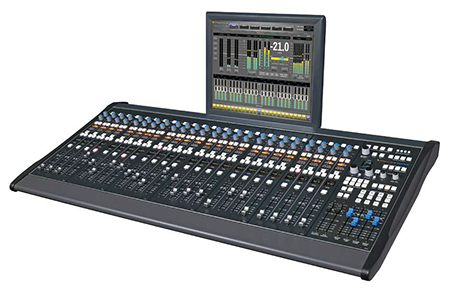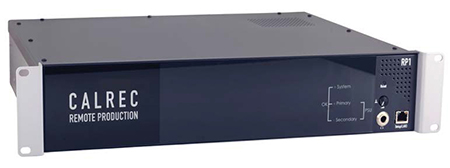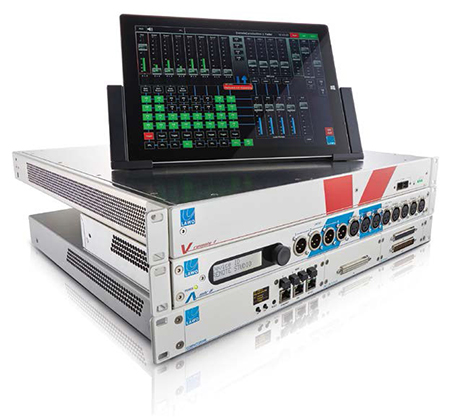AoIP and the Shape of Consoles to Come
LOS ANGELES—With the widespread adoption of AoIP networking transports by broadcast audio mixing console manufacturers, their products no longer necessarily conform to the stereotype of a desk-sized piece of equipment covered in knobs, switches, and faders. Instead, mixing, routing, and processing resources may now be distributed across a network, locally within a venue or over far greater geographical distances, heralding an evolution of broadcast audio workflows and a potential seachange in remote production methods.
At-home production, pioneered at events such as the Olympic Games and by Europe’s LiveIP project, a collaboration between the EBU, Belgium’s VRT, and a host of technology companies, now appears poised for adoption in the United States as well. The next logical step in remote production, the at-home workflow—whereby audio from a remote event is routed over an IP network to the home studio for either mixing and broadcast or recording and subsequent post production—is certainly on the radar for console makers.

Wheatstone’s Series Four IP television audio consoleEFFICIENCY AND COST SAVINGS
“This workflow is gaining in popularity as a way to lower production costs, often reducing what would be a truck full of equipment to mostly just the microphones and cameras needed on-site along with a small crew,” explained Lon Neumann, TV audio sales engineer for Wheatstone in New Bern, N.C. “Through IP audio networking, an IP console located at the home studio in, say, Los Angeles, can mix live sound from, say, the Wrigley ballpark in Chicago. IP-connected microphones and preamps deployed in the field can be controlled by the IP-64 or Dimension Three Touch [console system], instead of adding crew and equipment to do the same.”
Wheatstone’s WheatNet-IP is an AES67-compatible network comprising I/O and specialty Blades supporting audio mixing, routing, and control. For example, HD-SDI Blades can source and de-embed SDI audio directly from the camera, de-embedding it, and sending it home as discrete audio.
At the remote location, Blade functionality—DSP supporting audio ingest, processing, and routing—can reduce the need for other devices, saving weight and cost. At the home studio, or anywhere in the network, Neumann noted, “Wheatstone’s IP-64, Dimension Three Touch, LXE or Series Four mixers can turn mics on, control levels, and trigger IFBs remotely. And because most IP audio networks are now AES67-compatible, WheatNet-IP included, it’s a relatively small matter to transport audio from, say, a live sound group that might have one network platform, such as a WheatNet-IP system, and a broadcast truck that has another, such as Dante.”

Calrec’s RP1DIRECT CONTROL
Calrec rolled out its own remote production engine at the 2016 NAB Show. The RP1 unit incorporates local DSP, enabling the generation of monitor mixes and IFBs. Calrec’s offline editing interface allows remote engineers to set up latency-free IFB mixes for commentary or talent monitoring at the venue.
The RP1 embeds transmission audio into existing video transport mechanisms, allowing it to connect via Calrec’s Hydra2 analog, AES, MADI or SDI interfaces. AES67, Ravenna, Dante and SMPTE 2022 AoIP transports are supported in the 2RU unit.
The professional video industry's #1 source for news, trends and product and tech information. Sign up below.
“It gives an operator in a remote studio direct control over channel functions such as mic gains, aux send/monitor mix levels, and fader levels,” said Dave Letson, vice president of sales for the U.K.-based company. “On the console located at the main studio, all these remote I/O resources appear like any other local I/O box, so workflows are exactly the same as any other broadcast.”
Letson added, “Remote broadcasting using RP1 means fewer resources are needed on-site, and controlling audio from a remote console saves money on setup time, crew, logistics and equipment. It’s simple to set up, very easy to use, and enables broadcasters to cover a greater number of specialized events, making it possible to maintain a widening range of content.”

Lawo’s Remote Production kitDIAGNOSTIC TOOLS
Lawo similarly offers a standalone audio processor, the mc² MicroCore, which provides 192 DSP channels and a 512x512routing matrix. The unit may be controlled using Lawo’s touchscreen-optimized mxGUI software as well as by various external studio control systems, such as VSM, Evertz, Quartz, BFE, Pharos, Ross RAP, GV Ignite and Vizrt Mosart. Audio I/O is via AES67 and Ravenna, or over MADI, using Lawo’s optional A__madi 4 interface.
“The device is a perfect option for small-sized automated applications where external studio control systems are triggering the operation, such as in automated newsroom productions,” said Christian Struck, senior product manager audio production for Lawo in Germany. “The processing core provides extensive diagnostic tools for remote maintenance, including log files and http access, just like any mc² console.”
Additionally, Lawo’s 1RU Compact Engine supports AES67 and Ravenna plus a very broad array of analog and baseband-digital I/O. “It’s the perfect product when you’re ready to begin the transition to IP, but not quite ready to toss out everything and begin anew,” Struck added. “This device is ideal for collecting signals from a remote location for long distance remote productions with the possibility of on-site low-latency IFB mixes.”
The Ravenna/AES67-capable Compact Engine’s functions—EQ and dynamics, mixing and routing, delay, and other DSP capabilities—can be remote-controlled from the home mixing console. Additionally, VisTool software running on a tablet may be used to create custom control panels or touch-based mixing consoles for local control of the Compact Engine.
ALL-IN-ONE
Studer’s compact and budget-friendly Micro Series, an all-in-one digital audio mixing system, was initially designed for radio production but is also suited to remote production, according to Harman spokesman David Glaubke. The 3RU chassis houses DSP and I/O (identical to the Studer Vista 1 console), including eight Dante channels.
“The VoiceMix algorithm alleviates high-pressure broadcast situations by automatically mixing and processing up to 12 inputs,” said Glaubke. “This feature is incredibly beneficial in live, unscripted productions.”
A GUI provides full control. “All that is needed to operate the console is a network connection to the core, via the core’s integrated LAN or Wi-Fi hotspot, and an HTML5-capable web browser,” said Glaubke. “Simultaneous control from multiple devices is possible, allowing both on-site and remote control from the studio.”
Conversely, a single laptop or tablet can control multiple cores. But a computer is not even necessary; a screen, keyboard, and mouse may be directly connected to the unit. For those preferring tactile control, Studer offers an optional 6-fader Micro Series surface.
Steve Harvey began writing for Pro Sound News and Surround Professional in 2000 and is currently senior content producer for Mix and a contributor to TV Tech. He has worked in the pro audio industry—as a touring musician, in live production, installed sound, and equipment sales and marketing—since November 1980.
